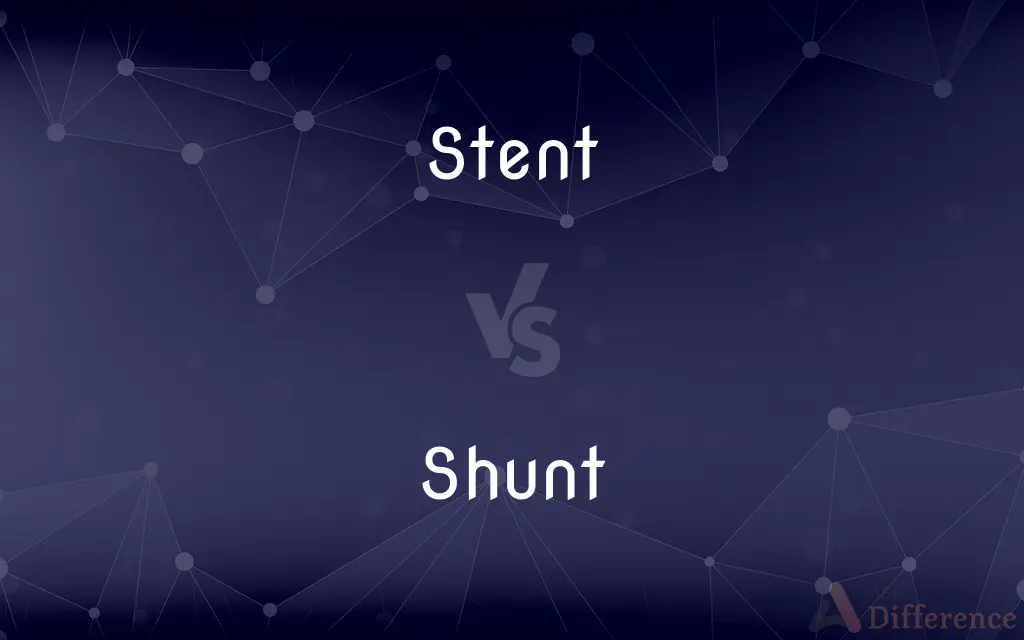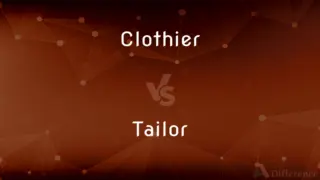Stent vs. Shunt — What's the Difference?
By Tayyaba Rehman — Updated on December 24, 2023
Stent is a tube inserted into a vessel or passage to keep it open. Shunt is a device or procedure that diverts fluid or blood from one pathway to another.

Difference Between Stent and Shunt
Table of Contents
ADVERTISEMENT
Key Differences
Stents are small, tube-like structures used to keep arteries open, ensuring proper blood flow. They are commonly used in coronary arteries to prevent or treat blockages. Shunts are devices or surgical procedures used to redirect bodily fluid from one area to another, often used to relieve pressure caused by fluid accumulation.
Stents are often used in procedures like angioplasty, where they are inserted into narrowed or blocked arteries. Shunts can be found in various medical applications, such as in treating hydrocephalus (excess fluid in the brain) by diverting cerebrospinal fluid.
The primary purpose of a stent is to maintain the openness of a passage, such as an artery or duct, to allow normal flow. A shunt, on the other hand, is intended to create an alternate pathway for fluid, often bypassing a damaged or obstructed area.
Stents are usually made of metal or plastic and are designed to be a permanent or semi-permanent solution to keep a passage open. Shunts can be various types, including tubing systems, and are designed to provide long-term diversion of fluid.
In summary, while both stents and shunts are medical devices used to treat obstructions in the body, stents are primarily for keeping passageways open, and shunts are for rerouting the flow of bodily fluids.
ADVERTISEMENT
Comparison Chart
Purpose
To keep a passage open
To divert fluid or blood
Common Use
In arteries to prevent blockages
To treat conditions like hydrocephalus
Function
Maintains openness of a vessel
Creates an alternate pathway for fluid
Material
Metal or plastic
Various, including tubing systems
Design
Tube-like structure
Device creating a diversion route
Compare with Definitions
Stent
A device to prevent vessel collapse.
A stent was inserted to keep her vein open.
Shunt
Diverts blood or fluid to another area.
A shunt was used to treat her hydrocephalus.
Stent
Often a permanent fixture in the body.
His stent will remain in place for life.
Shunt
Can be a temporary or permanent solution.
Her shunt may be removed if the condition improves.
Stent
Maintains blood flow in narrowed arteries.
The stent helped restore normal blood flow.
Shunt
Often used in neurosurgical procedures.
A shunt was necessary to drain the excess fluid.
Stent
A tube to keep arteries open.
He received a stent to treat his coronary artery disease.
Shunt
Creates an alternate pathway in the body.
The cardiac shunt diverted blood around the blocked artery.
Stent
In medicine, a stent is a metal or plastic tube inserted into the lumen of an anatomic vessel or duct to keep the passageway open, and stenting is the placement of a stent. There is a wide variety of stents used for different purposes, from expandable coronary, vascular and biliary stents, to simple plastic stents used to allow the flow of urine between kidney and bladder.
Shunt
Used to relieve pressure from fluid accumulation.
The doctor implanted a shunt in his brain.
Stent
A splint placed temporarily inside a duct, canal, or blood vessel to aid healing or relieve an obstruction.
Shunt
The act or process of turning aside or moving to an alternate course.
Stent
A substance used in dentistry for taking impressions of the teeth.
Shunt
A railroad switch.
Stent
An assessment of property made for purposes of taxation
It was recorded in the stent book
Shunt
(Electricity) A low-resistance connection between two points in an electric circuit that forms an alternative path for a portion of the current. Also called bypass.
Stent
Assess and charge (a person or a community) for purposes of taxation
Stent the Parish of Kildaltan in the ascertained sum
Shunt
(Medicine) A passage between two natural body channels, such as blood vessels, especially one created surgically to divert or permit flow from one pathway or region to another; a bypass.
Stent
A device used to support a bodily orifice or cavity during skin grafting or to immobilize a skin graft following placement.
Shunt
To turn or move aside or onto another course
Shunting traffic around an accident.
Stent
A short tubular device made of wire mesh or fabric that is placed permanently in an anatomical passage, usually an artery during angioplasty, to keep it open after occlusion.
Shunt
To evade by putting aside or ignoring
Urgent problems that society can no longer shunt aside.
Stent
A slender tube inserted into a blood vessel, a ureter or the oesophagus in order to provide support and to prevent disease-induced closure.
Shunt
To switch (a train or car) from one track to another.
Stent
(archaic) An allotted portion; a stint.
Shunt
(Electricity) To provide or divert (current) by means of a shunt.
Stent
(medicine) To insert a stent or tube into a blood vessel.
Shunt
(Medicine) To divert or permit flow of (a body fluid) from one pathway or region to another by surgical means.
Stent
(archaic) To keep within limits; to restrain; to cause to stop, or cease; to stint.
Shunt
To move or turn aside.
Stent
(archaic) To stint; to stop; to cease.
Shunt
(Electricity) To become diverted by means of a shunt. Used of a circuit.
Stent
To keep within limits; to restrain; to cause to stop, or cease; to stint.
Then would he weep, he might not be stent.
Yet n'ould she stentHer bitter railing and foul revilement.
Shunt
(transitive) To cause to move (suddenly), as by pushing or shoving; to give a (sudden) start to.
Stent
To stint; to stop; to cease.
And of this cry they would never stenten.
Shunt
(transitive) To divert to a less important place, position, or state.
Stent
An allotted portion; a stint.
Shunt
(transitive) To provide with a shunt.
To shunt a galvanometer
Stent
A slender tube inserted inside a tubular body part (as a blood vessel) to provide support during and after surgical anastomosis
Shunt
To move data in memory to a physical disk.
Stent
Used in angioplasty procedures.
The surgeon placed a stent during the angioplasty.
Shunt
To divert electric current by providing an alternative path.
Shunt
To move a train from one track to another, or to move carriages, etc. from one train to another.
Shunt
To have a minor collision, especially in a motor car.
Shunt
To divert the flow of a body fluid.
Shunt
To turn aside or away; to divert.
Shunt
To carry on arbitrage between the London stock exchange and provincial stock exchanges.
Shunt
An act of moving (suddenly), as due to a push or shove.
Shunt
(electricity) A connection used as an alternative path between parts of an electrical circuit.
Shunt
(firearms) The shifting of the studs on a projectile from the deep to the shallow sides of the grooves in its discharge from a shunt gun.
Shunt
An abnormal passage between body channels.
Shunt
(surgery) A passage between body channels constructed surgically as a bypass; a tube inserted into the body to create such a passage.
Shunt
(rail transport) A switch on a railway used to move a train from one track to another.
Shunt
A minor collision between vehicles.
Shunt
To shun; to move from.
Shunt
To cause to move suddenly; to give a sudden start to; to shove.
Shunt
To turn off to one side; especially, to turn off, as a grain or a car upon a side track; to switch off; to shift.
For shunting your late partner on to me.
Shunt
To provide with a shunt; as, to shunt a galvanometer.
Shunt
To go aside; to turn off.
Shunt
A turning off to a side or short track, that the principal track may be left free.
Shunt
A conducting circuit joining two points in a conductor, or the terminals of a galvanometer or dynamo, so as to form a parallel or derived circuit through which a portion of the current may pass, for the purpose of regulating the amount passing in the main circuit.
Shunt
The shifting of the studs on a projectile from the deep to the shallow sides of the grooves in its discharge from a shunt gun.
Shunt
A passage by which a bodily fluid (especially blood) is diverted from one channel to another;
An arteriovenus shunt
Shunt
A conductor having low resistance in parallel with another device to divert a fraction of the current
Shunt
Implant consisting of a tube made of plastic or rubber; for draining fluids within the body
Shunt
Transfer to another track, of trains
Shunt
Provide with or divert by means of an electrical shunt
Common Curiosities
Is a stent always made of metal?
Mostly, but some are made from fabric or other materials.
Can shunts be used in heart surgery?
Yes, especially to redirect blood flow.
How are shunts placed in the body?
Through surgical procedures.
Can stents be used in veins?
Yes, stents can be used in both veins and arteries.
Are shunts visible from outside the body?
No, they are implanted internally.
Can shunts become blocked?
Yes, which may require additional surgery.
Do stents require maintenance?
They typically do not, but regular medical check-ups are necessary.
Can children have shunts?
Yes, especially for conditions like hydrocephalus.
How long do stents last?
Many are designed to be permanent, but some are temporary.
How quickly do shunts work?
They usually start working immediately after surgery.
Are there risks to having a stent?
As with any medical procedure, there are risks, such as blood clots.
Can a stent improve heart function?
Yes, by improving blood flow to the heart.
Do stents set off metal detectors?
Generally, they do not.
Are shunts used in dialysis?
Yes, sometimes in kidney dialysis procedures.
Is recovery from stent placement usually quick?
Yes, many people recover quickly after stent placement.
Share Your Discovery

Previous Comparison
Wog vs. Aussie
Next Comparison
Clothier vs. TailorAuthor Spotlight
Written by
Tayyaba RehmanTayyaba Rehman is a distinguished writer, currently serving as a primary contributor to askdifference.com. As a researcher in semantics and etymology, Tayyaba's passion for the complexity of languages and their distinctions has found a perfect home on the platform. Tayyaba delves into the intricacies of language, distinguishing between commonly confused words and phrases, thereby providing clarity for readers worldwide.














































